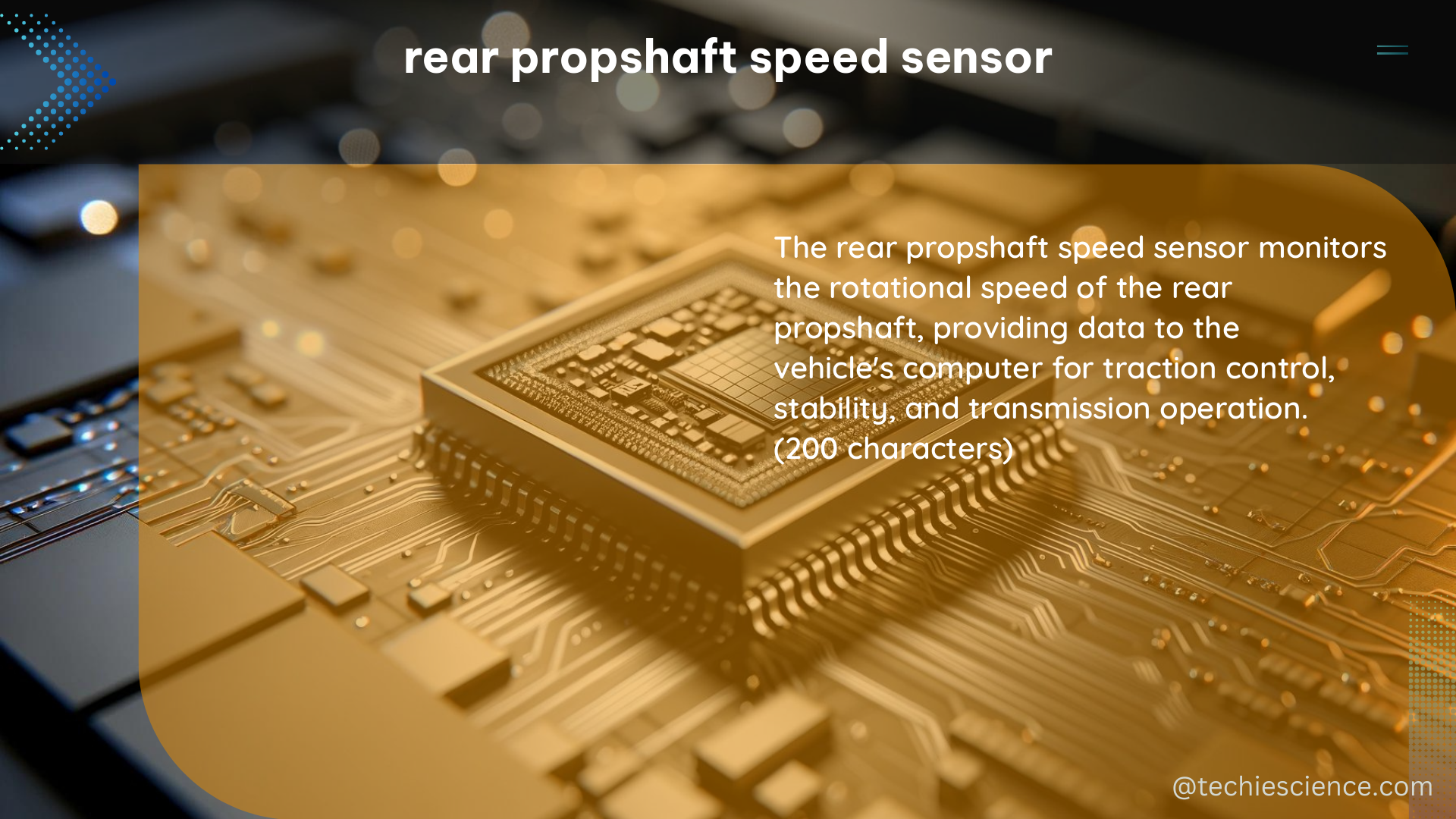The rear propshaft speed sensor, also known as the rear propeller shaft speed sensor, is a critical component in modern vehicles, particularly those equipped with automatic transmissions. This sensor plays a vital role in measuring the rotational speed of the rear propshaft, which is then utilized by the powertrain control module (PCM) to optimize gear shifting, enhance performance, and improve fuel efficiency.
Technical Specifications of Rear Propshaft Speed Sensor
-
Sensor Type: The rear propshaft speed sensor is typically a Hall effect sensor, which generates a voltage signal proportional to the speed of the propshaft.
-
Sensor Location: The sensor is usually positioned near the rear differential, and is connected to the propshaft via a toothed wheel or reluctor.
-
Measurement Range: The sensor has a specified measurement range, typically in the range of 0-10,000 RPM or higher, depending on the vehicle make and model.
-
Voltage Output Range: The sensor has a specified voltage output range, typically in the range of 0.5-4.5 volts, depending on the speed of the propshaft.
-
Response Time: The sensor has a specified response time, typically in the range of 1-10 milliseconds, depending on the vehicle make and model.
-
Sensor Construction: The rear propshaft speed sensor is composed of several key components, including:
- Hall effect element: Responsible for generating the voltage signal proportional to the propshaft speed.
- Toothed wheel or reluctor: Provides the input signal to the Hall effect element by rotating with the propshaft.
- Sensor housing: Protects the internal components and ensures proper alignment with the toothed wheel or reluctor.
-
Electrical connector: Allows the sensor to interface with the vehicle’s electrical system and transmit the speed signal to the PCM.
-
Sensor Accuracy: The accuracy of the rear propshaft speed sensor is crucial for the proper functioning of the vehicle’s powertrain control system. Typical accuracy specifications range from ±1% to ±3% of the actual propshaft speed, depending on the vehicle manufacturer’s requirements.
-
Sensor Durability: The rear propshaft speed sensor is designed to withstand the harsh operating conditions of the vehicle, including exposure to vibrations, temperature extremes, and environmental contaminants. Sensor housings are typically made of durable materials, such as stainless steel or high-strength plastics, to ensure long-term reliability.
Troubleshooting and Replacement

-
Sensor Testing: To test the rear propshaft speed sensor, you can use a multimeter to measure the voltage output of the sensor while the propshaft is rotating. The voltage signal should be within the specified range and vary proportionally with the propshaft speed.
-
Sensor Failure Symptoms: If the rear propshaft speed sensor is not producing a voltage signal, or the signal is outside the specified range, it may indicate a sensor failure. Common symptoms of a faulty sensor include:
- Erratic or inconsistent gear shifting
- Reduced engine performance or fuel efficiency
-
Illumination of the check engine light or transmission-related warning lights
-
Sensor Replacement: When replacing the rear propshaft speed sensor, it is crucial to ensure that the new sensor is properly aligned with the toothed wheel or reluctor and that the wiring is securely connected. Improper installation can lead to sensor malfunctions and further issues with the vehicle’s powertrain control system.
-
Sensor Compatibility: It is essential to use a replacement sensor that is specifically designed and approved for the make, model, and year of the vehicle. Using an incompatible sensor can result in performance issues, sensor malfunctions, or even damage to the vehicle’s electrical system.
Conclusion
The rear propshaft speed sensor is a critical component in modern vehicles, playing a vital role in the optimization of gear shifting, performance, and fuel efficiency. Understanding the technical specifications, troubleshooting procedures, and proper replacement guidelines for this sensor is essential for maintaining the overall health and performance of a vehicle’s powertrain system.
References
- HELLA Technical Information: Check and change ABS sensor
- Reddit post: Where is the rear propshaft speed sensor located?
- HELLA PAGID Technical Brochure: Brake Discs and Wheel Speed Sensors in ABS Systems

The lambdageeks.com Core SME Team is a group of experienced subject matter experts from diverse scientific and technical fields including Physics, Chemistry, Technology,Electronics & Electrical Engineering, Automotive, Mechanical Engineering. Our team collaborates to create high-quality, well-researched articles on a wide range of science and technology topics for the lambdageeks.com website.
All Our Senior SME are having more than 7 Years of experience in the respective fields . They are either Working Industry Professionals or assocaited With different Universities. Refer Our Authors Page to get to know About our Core SMEs.